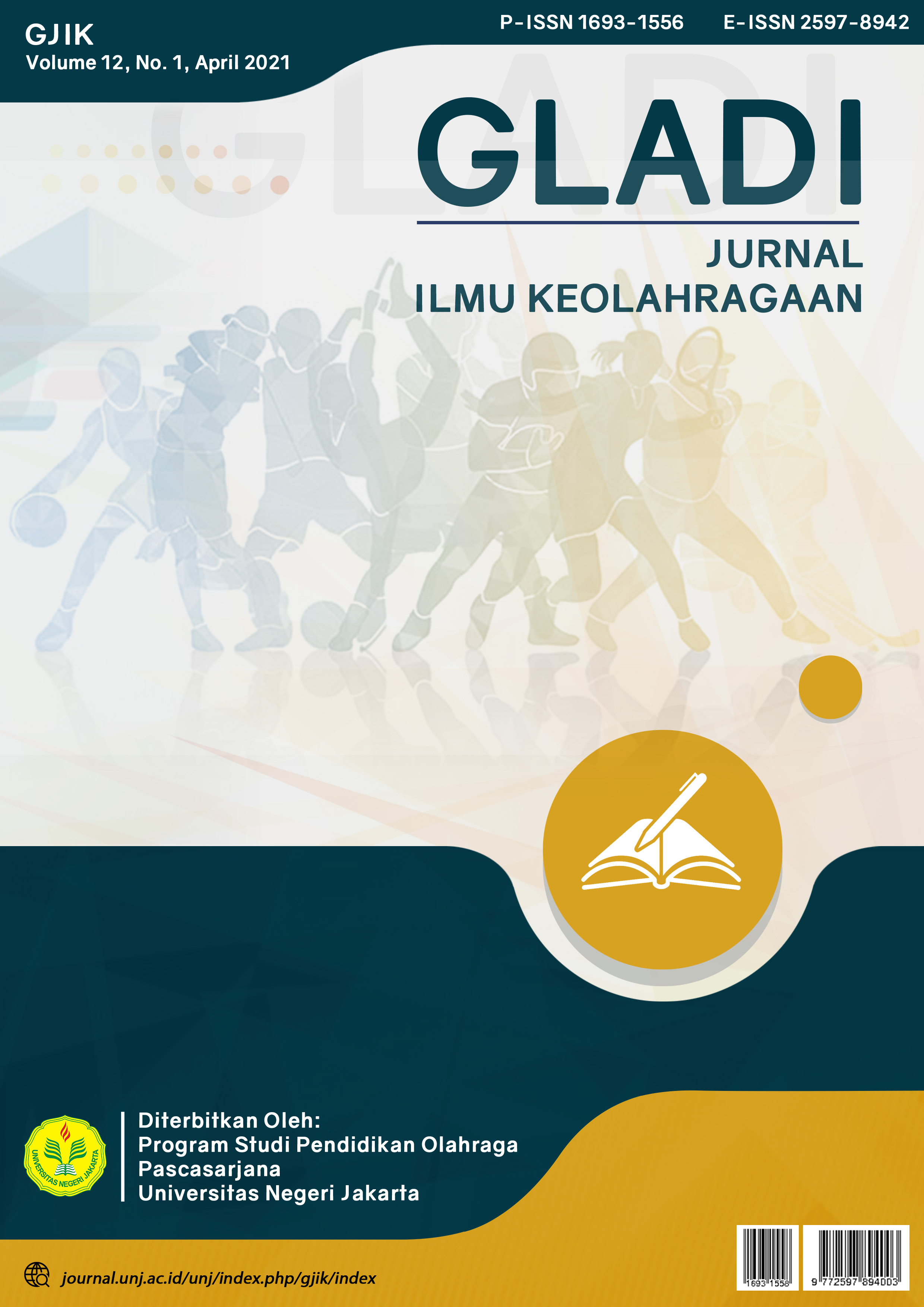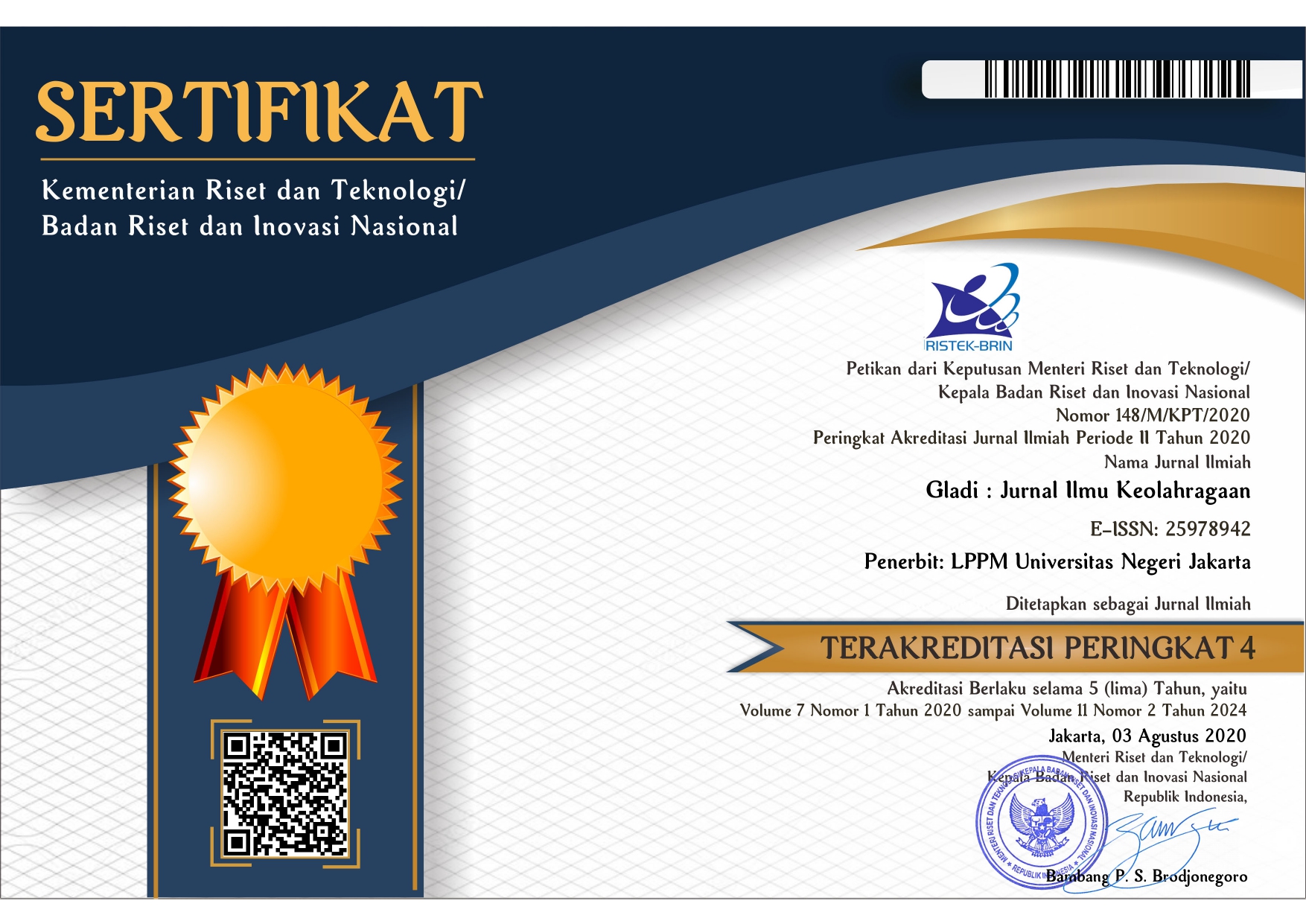EVALUATION OF LEARNING PHYSICAL EDUCATION IN THE COVID-19 PANDEMIC
DOI:
https://doi.org/10.21009/GJIK.121.08Keywords:
Effectiveness of learning, Learning Problems, Pandemic COVID-19Abstract
The purpose of this study was to determine the level of effectiveness of physical
education virtual learning during the COVID-19 pandemic first grade students of 6 junior high
school Bogor. The research method used is to use a descriptive qualitative research method,
namely a survey using Google form media which is carried out in each house. The population in
this study were students of 6 junior high school Bogor mounting to 306 students and using a sample
of 34 students in the same class. This study used an instrument in the form of a questionnaire with
variables. This research includes three aspects of affective, cognitive and psychomotor. Affective
here uses a research instrument in the form of a questionnaire to obtain research data with a total
of 18 questions with answer options Strongly, Agree, Disagree, Strongly Disagree Based on the
results of research analysis and discussion, it can be concluded that the level of physical education
learning during the COVID-19 pandemic can be broken down as follows the affective category
average is 33.56, the cognitive average is 89.56 and the psychomotor is 78.67. From the three data,
it was found that the average level of learning effectiveness was 67.27 with the category less
Downloads
References
B.Milman, N. (2015). Distance Education. International Encyclopedia of the Social & Behavioral Sciences: Second Edition. https://doi.org/doi.org/10.1016/B978-0-08- 097086-8.92001-4
Badar, I. T. (2009). Mendesain Model Pembelajaran Inovatif Progresif dan Kontekstual. Kencana.
Delima, M. I., Fitriasih, R. D., & Nugroho, R. T. (2017). Konsep Evaluasi Pembelajaran.
Dwiyogo, W. D. (2010). Dimensi Teknologi Pembelajaran Pendidikan Jasmani dan Olahraga. wineka Media.
Firman, F., & Rahayu, S. (2020). Pembelajaran Online di Tengah Pandemi Covid-19. Indonesian Journal of Educational Science (IJES), 2(2), 81–89. https://doi.org/10.31605/ijes.v2i2.659
Hanafy, M. S. (2014). Konsep Belajar Dan Pembelajaran. Lentera Pendidikan : Jurnal Ilmu Tarbiyah Dan Keguruan, 17(1), 66–79. https://doi.org/10.24252/lp.2014v17n1a5
Hera Yuniartik, T. H. &, & Nasuka. (2017). Evaluasi Pembelajaran Pendidikan Jasmani Olahraga dan Kesehatan di SLB C Se-Kota Yogyakarta. Journal of Physical Education and Sports, 6(2), 148–156. https://journal.unnes.ac.id/sju/index.php/jpes/article/view/17389
Irwanto. (2019). Evaluasi Proses Belajar Dan Pembelajaran Dengan Model Cipp Untuk Mata Pelajaran Penjasorkes Di Sekolah Menengah Kejuruan Negeri 2 Kota Serang. Jurnal Kejaora (Kesehatan Jasmani Dan Olahraga), 4(2), 6–13. https://doi.org/10.36526/kejaora.v4i2.656
Jamaris, M. (2010). Orientasi Baru dalam Psikologi Pendidikan. Yayasan Penamas Murni.
Jayul, A., & Irwanto, E. (2020). Model Pembelajaran Daring Sebagai Alternatif Proses Kegiatan Belajar Pendidikan Jasmani di Tengah Pandemi Covid-19. Urnal Pendidikan Kesehatan Rekreasi, 6(2), 190–199.
Khafid, M. (2008). Faktor Yang Mempengaruhi Ketuntasan Belajar Akuntansi : Motivasi Belajar Sebagai Variabel Intervening. Lembaran Ilmu Kependidikan, 37(1).
Majid, A. (2013). Strategi Pembelajaran. Remaja Rosdakarya.
Makmun, A. S. (2003). Psikologi Pendidikan. Rosda Karya Remaja.
Pambudi, M. I., Winarno, M., & Dwiyogo, W. D. (2019). Perencanaan dan Pelaksanaan Pembelajaran Pendidikan Jasmani Olahraga Kesehatan. Jurnal Pendidikan Olahraga, Universitas Negeri Malang, 4(1), 110–116. http://journal.um.ac.id/index.php/jptpp/
Pane, A., & Darwis Dasopang, M. (2017). Belajar Dan Pembelajaran. FITRAH:Jurnal Kajian Ilmu-Ilmu Keislaman, 3(2), 333. https://doi.org/10.24952/fitrah.v3i2.945
Paramitha, S. T. (2008). Pengembangan Permainan Bola Basket untuk Proses Pembelajaran Pendidikan Jasmani, Olahraga dan Kesehatan Siswa Sekolah Dasar. Universitas Negeri Semarang.
Prilanji, F.B., Simanjutak, V.G., Haetami, M. (2019). Evaluasi Pembelajaran Penjasorkes. Jurnal Pendidikan Dan Pembelajaran Khatulistiwa, Vol. 8 No.
Putro, E. (2016). Hasil Pembelajaran Di Sekolah. Pustaka Belajar.
Rahayu, E. T. (2013). Strategi pembelajaran pendidikan jasmani. Alfabeta.
Raibowo, S., & Nopiyanto, Y. E. (2020). Jurnal Pendidikan Kesehatan Rekreasi Evaluasi Pembelajaran Pendidikan Jasmani Olahraga & Kesehatan pada SMP Negeri Se-Kabupaten Mukomuko melalui Pendekatan Model Context , Input , Process & Product ( CIPP ) PENDAHULUAN Program pemerataan pendidikan telah. Jurnal Pendidikan Kesehatan Rekreasi, 6(2), 146–165. https://doi.org/10.5281/zenodo.3881891
Samsudin. (2010). Perencanaan Pembelajaran Pendidikan Jasmani dan Olahraga. wineka Media.
Sugiyanto. (2007). Perkembangan dan Belajar Motorik. Mendikbud.
Sunarto, & Hartanto, A. (2006). Perkembangan Peserta Didik. Rineka Cipta.
Syah, M. (2003). Psikologi Belajar. Raja Grafindo Persada.
Taufik, M., & Pardijono. (2013). Efektivitas Pembelajaran Pendidikan Jasmani Di Sma Negeri Surabaya Tentang Pemanfaatan Sarana Dan Prasarana Dalam Kegiatan Ekstrakurikuler Tahun Pelajaran 2012/2013. Jurnal Pendidikan Olahraga Dan Kesehatan, 01(2), 392–399. https://doi.org/10.1017/CBO9781107415324.004
https://doi.org/10.18860/jt.v2i2.1826
Yandwiputra, A. R. (2020). Kuliah Jarak Jauh karena Virus Corona, UI: Bukan Lockdown. Tempo.Co.







